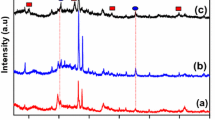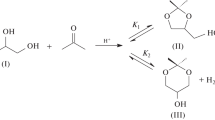Abstract
Oligomerization of glycine (gly) and diglycine (gly2) on montmorillonite was performed as cyclic, drying-wetting process at temperatures below 100°C, under varying reaction conditions. The influence of substrate/clay ratio, temperature and pH was found to be different for amino acid (AA) dimerization, cyclic anhydride (CA) formation and peptide chain elongation. High temperatures and neutral pH favour CA formation over diglycine production. An AA/catalyst ratio of 0.2 mmol/g leads to optimal yields. This supports the assumption that amino acid dimerization and CA formation take place at the edges of clay particles. Peptide chain elongation, starting from gly2, produces higher yields at higher temperatures and neutral pH.
Similar content being viewed by others
References
N. Lahav, D. White and S. Chang, Science 201 (1978) 67.
J.G. Lawless and N. Levi, J. Mol. Evol. 13 (1979) 281.
D.H. White and J.C. Erickson, J. Mol. Evol. 16 (1980) 279.
D.H. White and J.C. Erickson, J. Mol. Evol. 17 (1981) 19.
B.M. Rode, J. Bujdák and A.H. Eder, Trends Inorg. Chem. 3 (1993) 45.
J. Bujdák, H. Slosiariková, N. Texler, M. Schwendinger and B.M. Rode, Monatsh. Chemie 125 (1994) 1033.
J. Bujdák, A. Eder, Y. Yongyai, K. Faybíková and B.M. Rode, Origins Life Evol. Biosph. 25 (1995) 431.
D.H. White, M. Kenedy and J. Macklin, Origins Life Evol. Biosph. 14 (1984) 273.
J. Bujdák, A. Eder, Y. Yongyai, K. Faybíková and B.M. Rode, J. Inorg. Biochem. 61 (1996) 69.
B. Číčel, P. Komadel, E. Bednáriková and J. Madejová, Geol. Carpathica, Ser. Clays 1 (1992) 3;
J. Madejová, P. Komadel, B. Číčel, Geol. Carpathica, Ser. Clays 1 (1992) 9.
D.J. Greenland, R.H. Laby and J.P. Quirk, Trans. Faraday Soc. 61 (1965) 2024.
W.F. Hofer, Clays Clay. Miner. 18 (1970) 97;
M.J. Frissel and G.H. Bolt, Soil Sci. 94 (1962) 284;
R. Haque and R. Sexton, J. Coll. Interf. Sci. 27 (1968) 818.
J.P. Rupert, W.T. Granquist and T.J. Pinnavaia, in:Chemistry of Clays and Clay Minerals, ed. A.C.D. Newman (Longman, Singapore, 1987) ch. 6.
D.J. Greenland, R.H. Laby and J.P. Quirk, Trans. Faraday Soc. 61 (1965) 2013.
N. Lahav and S. Chang, J. Mol. Evol. 8 (1976) 357.
Author information
Authors and Affiliations
Rights and permissions
About this article
Cite this article
Bujdák, J., Le Son, H., Yongyai, Y. et al. The effect of reaction conditions on montmorillonite-catalysed peptide formation. Catal Lett 37, 267–272 (1996). https://doi.org/10.1007/BF00807765
Received:
Accepted:
Issue Date:
DOI: https://doi.org/10.1007/BF00807765




